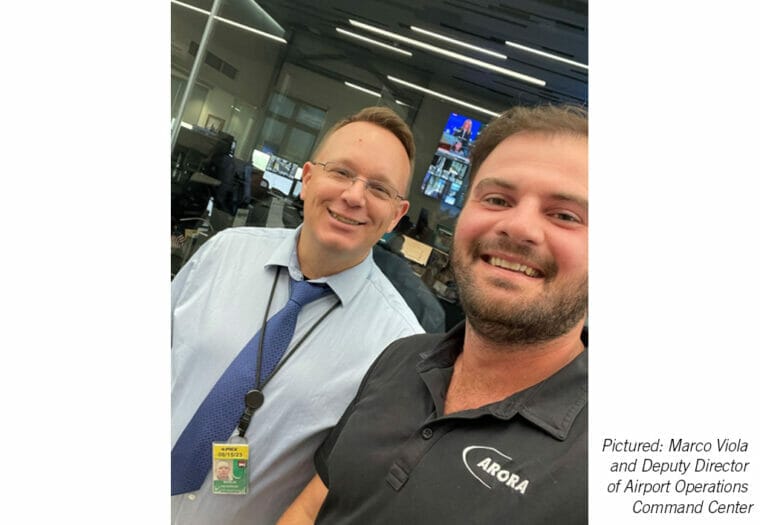News | May 16, 2023 | Christyn Binder
Arora’s Key Takeaways from the 2023 IFMA Airport Council’s Spring Meeting
The 2023 IFMA Airport Council’s Spring Meeting, hosted by Sky Harbor International Airport, brought together industry professionals and thought leaders to discuss and exchange insights on the latest trends, challenges, and advancements in airport facilities management. Arora and our subsidiary company, EDI, were honored to serve as a Platinum Sponsor.
Arora’s own Marco Viola, Vice President, Global Business Development, Enterprise Solutions, was proud to join his colleagues at this year’s meeting and collected key takeaways on the noteworthy discussions and trends shared at the event which highlighted the importance of asset management, communication, sustainability, and technology in optimizing airport operations and passenger experiences.
Key Takeaway 1: Successful Asset Management Metrics
During the meeting, presenters discussed the key metrics for successful asset management programs. Understanding asset installation dates, the number of historic work orders associated with each asset, and asset life expectancy were deemed crucial metrics for any effective asset management program. This data allows airports to make informed decisions regarding maintenance, repair, and replacement of assets, ensuring smooth operations and reducing downtime.
Key Takeaway 2: Mapping Facilities for Operational Efficiency and Communication Improvement
Presenters and panelists emphasized airports’ increasing need to map their facilities not only for operational purposes but also to effectively communicate the status of their infrastructure. Having a clear understanding of where assets are, and the condition of their equipment, is vital for efficient decision-making and securing project funds. By implementing indoor maps and advanced communication systems, airports can streamline their processes, enhance collaboration, and improve overall facility management. In addition, mapping can help airport leaders more effectively implement crisis management strategies, emergency response protocols, and business continuity plans.
In her session detailing a Maintenance Project Communications Study, Kelly Phelps of PSM2 shared that organizations are increasingly relying on indoor maps to communicate project updates and changes within their facilities. This session shed light on the importance of using visual tools to convey information effectively and help stakeholders understand the status of ongoing maintenance projects. By leveraging indoor maps, airports can enhance communication, facilitate collaboration, and improve project management efficiency.
Key Takeaway 3: Capital Improvement Projects and Facility Redesign
The meeting host, Sky Harbor International Airport, highlighted their significant investments in capital improvement projects, and the challenges their facility operators face during the design and construction process. For example, Terminal 4 at Sky Harbor International Airport is slated for redesign yet handles roughly 80% of the airport’s traffic, forcing the airport’s facility managers to think strategically about to achieve their redesign without completely interrupting normal operations.
The meeting emphasized the value of cooperation between airport operators, airlines, government agencies, and service providers in driving innovation and delivering exceptional airport experiences.
Key Takeaway 4: Maintaining Unseen Assets with Enterprise Asset Management Systems
In his session, Tim Dodson, Senior Asset Manager, CVG, educated attendees on the importance of efficiently maintaining assets that are not visible with sophisticated Enterprise Asset Management (EAM) systems. These systems play a crucial role in managing and tracking assets that are not easily accessible or visible. With a comprehensive EAM, airports can optimize maintenance schedules, reduce downtime, and extend the life of critical infrastructure components.
Key Takeaway 5: Sustainability Initiatives and Partnerships
Sustainability emerged as a significant focus area during the meeting. Knut Herrmann, PHX Energy Management Engineer and Jennifer Maples, PHX Special Projects Administrator shared that many airports, including Sky Harbor International Airport (PHX), are committed to achieving “net zero” goals in the coming years. PHX and other airports are actively seeking collaborations with organizations offering sustainability solutions. PHX, for example, is launching the “Green Business Partner Program” to foster partnerships and implement environmentally friendly initiatives such as EV charging stations. Deep understanding of design principles and utility capacity/load analysis is crucial for successful sustainability projects.
Marco also observed a significant focus on incorporating renewable energy sources, optimizing resource usage, and reducing carbon footprints. Sky Harbor International Airport shared its success story in implementing sustainable practices, including solar energy generation, water conservation measures, and waste management strategies. The airports operations command centers solar-covered parking has a 210kW capacity and can generate 357,000kWh of power yearly. This is enough to run 33 family houses, or chill 3.47 million gallons of beer. This system avoids 183.4 metric tons of CO2 annually, which is equal to removing 40 gasoline automobiles off the road.
The emphasis on sustainability reaffirmed the aviation industry’s commitment to environmental stewardship and the need for innovative solutions to mitigate the mounting impacts of climate change.
Key Takeaway 6: Smarter Airport Management with Arora ATLAS
Marco’s presentation, Smarter Airport Management with Indoor Maps and Mobile Solutions, generated a lot of excitement around the idea of achieving better Airport Management through the integration of Indoor maps with a mobile asset management solution like Arora ATLAS®. Marco explained that the integration of Indoor GIS and ATLAS allows key staff to manage all pertinent facility information in one authoritative system and engage with different stakeholders through desktop and mobile applications to solve for their most complex space management, asset management, workorder management and passenger experience challenges.
In addition, the meeting highlighted the critical role of technology in enhancing the overall passenger experience. Presenters discussed the implementation of smart airport concepts, including real-time information displays, automated security systems, and advanced wayfinding solutions.
From maximizing asset management efficiency to embracing sustainability initiatives and implementing smarter airport management solutions, Arora gained valuable insights on the future of airport infrastructure at this year’s IFMA Airport Council’s Spring Meeting. We look forward to seeing our colleagues at IFMA World Workplace, September 20-21, 2023 in Kansas City, come see us at Booth 578!




